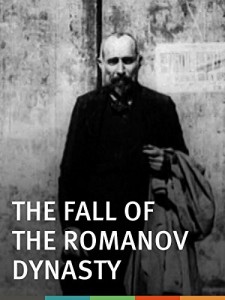SYNOPSIS: Fall of the Romanov Dynasty is a documentary film by woman Soviet filmmaker Esfir Shub. As a member of the revolutionary avant-garde, Shub constructed this narrative documentary entirely through editing found stock footage, creating what scholars believe is the first Soviet montage. Shub compiled this film in order to give the first historical account of the events that led to the October Revolution. Juxtaposed with classical music and interlaced text on black background, Shub describes in a propagandistic manner the social and political unrest across Russia during the years between 1913 to 1917, culminating in the victory of the Bolsheviks. The film traces in chronological order class tensions, the brutality of the First World War, and a pointed negligence of the Tsar and his ministers– all catalysts of a revolution. Notable highlights include juxtaposed shots of the bourgeois leisure with peasant workers, portrait shots of ministers from the “hateful regime,” soldiers fighting in trenches on the front lines, and workers marching on the streets with signs of celebration. The film ends with footage of Lenin informally shaking hands with a worker.
Esfir Shub was part of the Lev collective, an avant-garde literary and visual publication that fully embraced the communist conception of artist as worker. Working within a larger Constructivist moment, Shub was allowed the resources and opportunity to work with male artists as equals and thus, contributed this propagandistic film to the promotion of the communist party. 
You can find the film at: https://www.youtube.com/watch?v=mFbxPqyHErQ
To learn more about gender and Soviet film, visit: https://www.jstor.org/stable/3815583?seq=1#metadata_info_tab_contents
Stollery, Martin. “Eisenstein, Shub and the Gender of the Author as Producer.” Film History: An International Journal, vol. 14, no. 1, 2002, pp. 87–99., doi:10.2979/fil.2002.14.1.87.
Photo from IMDb.
Bellara Huang, Fall 2019, Feminist Film and Media Studies

